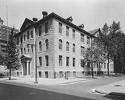The Rapp Surname and Homeopathy
December 29, 2008
 The Rapp surname originated in Germany and
Immigrated to America, spreading homeopathy all the way…
The Rapp surname originated in Germany and
Immigrated to America, spreading homeopathy all the way…
 Frederick Reichert
von Rapp 1775 - 1834 adopted son of Johann Georg Rapp was a
patient
of homeopath Constantine
Hering and a
strong advocate of
homeopathy.
Frederick Reichert
von Rapp 1775 - 1834 adopted son of Johann Georg Rapp was a
patient
of homeopath Constantine
Hering and a
strong advocate of
homeopathy.
Frederick von Rapp was the Administrator and Provost of the Hahnemann Hospital in Pensylvania in 1935.
 Georg von Rapp 1818 - 1886
MD University Wurzburg
1842
held the Chair of
Homeopathy and
the Chair of Pathology and
Therapeutics
at the University in
Tubingen.
Georg von Rapp 1818 - 1886
MD University Wurzburg
1842
held the Chair of
Homeopathy and
the Chair of Pathology and
Therapeutics
at the University in
Tubingen.
 Johann Georg
Rapp 1757 – 1847 was born
in Germany and immigrated to Pennsylvania, was the founder of the
religious sect called Harmonists, Harmonites, Rappites, or the Harmony
Society.
Johann Georg
Rapp 1757 – 1847 was born
in Germany and immigrated to Pennsylvania, was the founder of the
religious sect called Harmonists, Harmonites, Rappites, or the Harmony
Society.
Johann Georg Rapp was a patient of homeopath William Wesselhoeft.
Born in Iptingen, Duchy of Württemberg, Germany, Rapp became inspired by the philosophies of Jakob Bohme, Philipp Jakob Spener, and Emanuel Swedenborg, among others. In the 1780s, George Rapp began preaching and soon started to gather a group of his own followers.
His group officially split with the Lutheran Church in 1785 and was promptly banned from meeting.
The persecution that Rapp and his followers experienced caused them to leave Germany and come to the United States in 1803.
Rapp was a Pietist, and a number of his beliefs were shared by the Anabaptists, as well as groups such as the Shakers. Rapp’s religious beliefs and philosophy were the cement that held his community together both in Germany and in America – a Christian community and commune, which in America organized as the Harmony Society.
The Harmony Society built three American towns, became rich, famous, and survived for 100 years – roughly from 1805 until 1905…
Rapp adopted Frederick Reichert (1775-1834), who organized the move of Rapp’s followers from Württemberg to America in 1804. In America, Frederick was the business leader and public spokesman for the Harmony Society.
To the great consternation of church and state authorities, this mere peasant from Iptingen had become the outspoken leader of several thousand Separatists in the southern German duchy of Württemberg.
In 1798, Rapp and his group of followers had further distanced themselves from mainstream society. In the Lomersheimer Declaration, written in 1798, Rapp’s followers refused to serve in the military or attend Lutheran schools.
Rapp was summoned to Maulbronn for an interrogation and the government confiscated Separatist books. When released in 1803, Rapp told his followers to pool their assets and follow him on a journey for safety to the “land of Israel” in the United States, and soon over 800 people were living with him there.
The initial move scattered the followers and reduced Rapp’s original group of 12,000 to many fewer persons. In 1804, Rapp was able to secure a large tract of land in Pennsylvania and started his first commune. This first commune, ‘Harmonie’, (Harmony), Butler County, Pennsylvania, soon grew to a population of about 800, and was highly profitable.
At Harmony, the Harmony Society was formally organized on February 15, 1805, and its members contracted to hold all property in common and to submit to spiritual and material leadership by Rapp and associates.
In 1807, celibacy was advocated as the preferred custom of the community in an attempt to purify themselves for the coming Millennium.
In 1814, the society sold their first town in Pennsylvania to Mennonites for 10 times the amount originally paid for the land, and the entire commune moved out west to Indiana where
their new town was also known as Harmony. Ten years after the move to Indiana the commune moved again, this time it returned to Pennsylvania and named their town ‘Ökonomie’, Economy. The Indiana settlement was sold to Robert Owen, at which point it was renamed New Harmony, Indiana.
George Rapp lived out his remaining days in the town of Economy, Pennsylvania, until August 7, 1847, when he died at the age of 89.
Rapp was the son of Hans Adam Rapp (1720-71) and Rosine Berger. He had one brother, Adam, and three sisters, Marie Dorothea, Elise Dorothea, and Maria Barbara. George Rapp married Christine Benzinger in 1783 and the couple had two children, Johannes (1783-1812) and Rosine (1786-1849). Johannes, trained as a surveyor, died at age 29 in an industrial accident. His is the only name listed on a stone in the Harmonist cemetery in Harmony, Pennsylvania - the Harmonists did not mark their graves. The stone was donated by Non-Harmonists, and the Society accepted it reluctantly. The location of Johannes’ grave within the cemetery is unknown. Johannes’ daughter, Gertrude (1808-89), later became a minor American celebrity and organized the Society’s silk production at Economy, Pennsylvania.
Rapp adopted Frederick Reichert (1775-1834), who organized the move of Rapp’s followers from Württemberg to America in 1804. In America, Frederick was the business leader and public spokesman for the Harmony Society.
Rapp was tall, blue eyed, broad shouldered, with long hair and a patriarch’s beard. He had a powerful voice, which matched his commanding presence. Rapp trained as a journeyman weaver and learned the art of wine making. Grapevines and wine were prominent in all three Harmonite towns. continue reading: